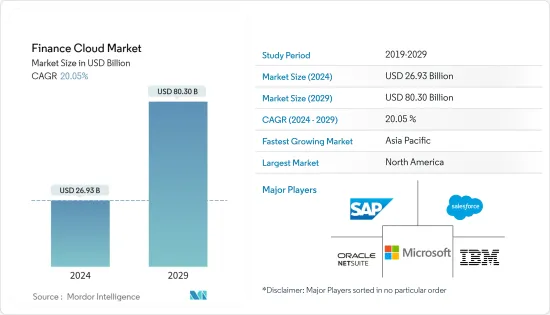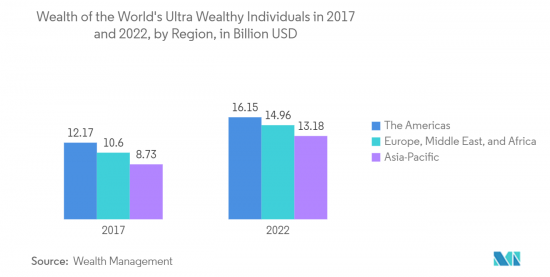 |
市場調查報告書
商品編碼
1402969
金融雲-市場佔有率分析、產業趨勢與統計、2024年至2029年的成長預測Finance Cloud - Market Share Analysis, Industry Trends & Statistics, Growth Forecasts 2024 - 2029 |
||||||
價格
※ 本網頁內容可能與最新版本有所差異。詳細情況請與我們聯繫。
簡介目錄
金融雲市場規模預計到 2024 年為 269.3 億美元,預計到 2029 年將達到 803 億美元,在預測期內(2024-2029 年)複合年成長率為 20.05%。

隨著收益的增加,雲端增加了產生的潛在客戶數量並提供了更好的定價。
主要亮點
- 銀行服務以及金融和保險公司正在選擇數位應用程式來快速回應持續的客戶詢問、考慮長期利益並獲得競爭優勢。例如,Ess Kay Fincorp 選擇雲端基礎的貸款平台來數位化其整個貸款業務,並將貸款核准時間減少 33%。
- 提高業務效率也是推動金融雲市場成長的因素之一。 Roha Housing Finance 希望在兩小時內發放貸款,而不是傳統的三天。透過利用雲端基礎的技術的敏捷性和成本效率來提供「客戶至上」的方法,該公司可以在 7 天內處理端到端貸款,比現有的住宅行業基準快 50%。
- 在印度、中國、巴西、非洲等新興國家地區,金融雲端處理服務市場拓展空間龐大。例如,監控和分析軟體供應商 ITRS Group Ltd. 預測,今年亞太地區 86% 的金融服務業將使用公有雲。透過利用雲端基礎的應用程式,企業可以大幅降低採購、維護和升級 IT 系統和設備的成本。
- 然而,資料安全和保護問題、高昂的投資和維護成本正在限制金融雲端產業的擴張。資料遺失通常會損害雲端儲存的安全性。資訊可能會因電腦病毒、駭客攻擊和系統故障而完全受到損害,而不是被竊取或共用。
- COVID-19的疫情對金融雲市場產生了正面影響。隨著全球 COVID-19 病例激增,經濟放緩。然而,儘管發生了大流行,銀行、保險和金融服務業仍繼續運作。疫情期間,金融機構被迫迅速採用遠距辦公,促使對雲端基礎的基礎設施的投資。德意志銀行和 Google Cloud 在 COVID-19 期間簽署了為期 10 年的策略雲端合作夥伴協議。此次合作預計將提高彈性、快速創造新技能並降低成本。
金融雲市場趨勢
財富管理產業主導市場
- 隨著世界財富的增加,財富管理專業人士的數量也不斷增加。瑞士信貸今年的財富報告顯示,去年財富成長強勁,截至年終,以目前外匯計算,全球財富總合463.6兆美元,成長9.8%。
- 事實上,根據加拿大皇家銀行財富管理公司 (RBC Wealth Management) 的數據,去年這些人最集中的地區是北美,那裡有 790 萬富裕人士。去年亞太地區的富裕人士人數為 720 萬人。擁有100萬美元或以上資產的個人是淨資產最高的個人。
- 報告稱,未來五年全球財富預計將成長約26%,明年將達到399兆美元。中階的成長將成為財富的關鍵驅動力,未來五年億萬富翁的數量將激增,達到 5,500 萬的歷史新高。
- 事實上,富裕人士的需求很大。他們的業務競爭比以往任何時候都更加激烈。因此,公司必須利用金融雲等最尖端科技繼續創新並在不斷成長的市場中佔據更大佔有率。
- 人工智慧的日益普及是市場的新趨勢之一。財富管理是金融服務業中最早大量利用人工智慧技術的領域之一。 AI運算會產生龐大的金融資料集,因此AI應用需要使用雲端網路。因此,由於人工智慧在金融領域的使用不斷增加,金融雲市場也有望在研究期間出現。

亞太地區將經歷最高的成長
- 亞太地區的金融機構正在進行數位轉型。這使得金融機構能夠提高成本效率。例如,在印度,印度政府正在透過金融科技等措施致力於付款系統數位化並擴大金融包容性,即 Jan Dhan Yojana、Aadhaar 和 UPI 統一支付介面。
- 去年四月,中國央行宣布將加速中國金融科技基礎設施的發展,以適應日益受到資料、人工智慧和大科技影響的金融業。這包括更新連接所有央行分店的資料中心和網路,以及去年建立「央行雲端」。
- 由於 BFSI 行業不斷變化,印度的小型金融銀行 (SFB) 已處於發展的早期階段。這些金融機構希望制定可行的產業計畫,以滿足社會弱勢群體的需求。許多現代銀行正在採用雲端和人工智慧/機器學習來快速評估風險,並為客戶做出更快、更資訊的決策。
- 在公共部門舉措、中小企業以及銀行、金融服務和保險 (BFSI) 行業數位創新的幫助下,科技巨頭 Oracle 公司在印度 (SME) 的雲端業務方面取得了重大進展。借助Oracle雲,銀行可以減少對資料中心基礎設施的依賴、僅按使用量付費以及將容量與業務需求相匹配,從而實現價值最大化。據 Oracle 稱,與使用其他雲端供應商的銀行相比,使用其雲端的銀行可降低高達 50% 的成本。
金融雲業概況
金融雲市場競爭激烈,由幾個主要企業組成。為了鞏固市場地位,參與企業正在採取產品創新、聯盟和併購等策略。
- 2023 年 2 月 - 軟體投資公司 Thoma Bravo 宣布完成 Coupa Software 約 80 億美元的收購,Coupa Software 提供雲端基礎的業務支出管理平台,整合了跨供應鏈、採購和財務職能的流程。
- 2022 年 1 月 - 軟體即服務 (SaaS) 和業務流程即服務 (BPaaS) 供應商 Avaloq 繼續加強與加拿大皇家銀行旗下 RBC 財富管理公司在亞洲的長期合作夥伴關係。我們還將協助 RBC Wealth Management 推進其雲端基礎的SaaS 模式,並透過引入更複雜的解決方案來實現其財富管理平台的現代化。
其他福利
- Excel 格式的市場預測 (ME) 表
- 3 個月的分析師支持
目錄
第1章簡介
- 研究假設和市場定義
- 調查範圍
第2章調查方法
第3章執行摘要
第4章市場洞察
- 市場概況
- 產業吸引力-波特五力分析
- 新進入者的威脅
- 買家/消費者的議價能力
- 供應商的議價能力
- 替代品的威脅
- 競爭公司之間的敵對關係
第5章市場動態
- 市場促進因素與市場抑制因素簡介
- 市場促進因素
- 客戶關係管理改善需求
- 金融業業務效率需求
- 市場抑制因素
- 雲端基礎的網路威脅的興起
第6章市場區隔
- 按解決方案/服務
- 財務預測
- 財務報告與分析
- 風險與合規性
- 管理服務
- 按發展
- 公共雲端
- 私有雲端
- 按地區
- 北美洲
- 歐洲
- 亞太地區
- 拉丁美洲
- 中東/非洲
第7章競爭形勢
- 公司簡介
- Oracle 公司(和 Netsuite)
- IBM Corporation
- Microsoft Corporation
- Salesforce.com Inc.
- SAP SE
- Sage Intacct Inc.
- Workday, Inc.
- Unit4(and FinancialForce)
- Acumatica Inc.
- Huawei Technologies Co. Ltd
第8章投資分析
第9章 市場機會及未來趨勢
簡介目錄
Product Code: 46324

The Finance Cloud Market size is estimated at USD 26.93 billion in 2024, and is expected to reach USD 80.30 billion by 2029, growing at a CAGR of 20.05% during the forecast period (2024-2029).
Along with increased revenue, the cloud increases the number of leads generated and offers better pricing.
Key Highlights
- Banking services and financial and insurance companies are opting for digital applications to quickly address customers' ongoing queries, along with keeping into consideration the long-term benefits and achieving a competitive advantage. For instance, Ess Kay Fincorp chose a cloud-based lending platform to digitize its entire lending business and decrease its loan approval time by 33%.
- Operational efficiency is another factor driving the growth of the finance cloud market. Roha Housing Finance wanted to issue loans within two hours instead of three days. After adopting the agility and cost efficiency of cloud-based technology to offer a "customer-first" approach, it was able to provide end-to-end loan processing in seven days, which is 50% faster than the benchmark for the housing finance industry.
- In developing nations and areas like India, China, Brazil, and Africa, the market for financial cloud computing services has a lot of room to expand. For instance, the ITRS Group Ltd., a monitoring and analytics software provider, predicted that 86% of the Asia Pacific financial services industry would use the public cloud this year. By utilizing cloud-based applications, businesses can significantly reduce the cost of purchasing, maintaining, and upgrading IT systems and equipment.
- However, problems with data security and protection and expensive investment and maintenance expenses limit the expansion of the finance cloud industry. Data loss routinely puts cloud storage's security in jeopardy. Information can be affected entirely by a computer virus, hacking, or a broken system instead of being stolen and shared.
- The COVID-19 epidemic had a favorablly impacted on the financial cloud market. Due to an upsurge of COVID-19 cases worldwide, the economy slowed down. However, the banking, insurance, and financial services industries continued to function despite the pandemic. During the epidemic, financial institutions were forced to rapidly adopt remote working, which prompted investment in a cloud-based infrastructure. Deutsche Bank and Google Cloud signed a 10-year strategic cloud collaboration agreement during COVID-19. The alliance is anticipated to boost resilience, quicken the creation of new skills, and cut costs.
Finance Cloud Market Trends
Wealth Management sector to Dominate the Market
- As global wealth increases, there is a rise in wealth management professionals. As per the Credit Suisse Wealth Report of the current year, wealth grew at a strong pace last year, and by year's end, global wealth at prevailing exchange rates totaled USD 463.6 trillion, a gain of 9.8%.
- In fact, according to RBC Wealth Management, North America accounted for the most significant concentration of these people last year with 7.9 million HNWIs living there. The number of HNWIs reported in the Asia Pacific region was 7.2 million last year. The individuals with a fortune of over USD 1 million are the highest Networth Individuals.
- The same report indicates that global wealth is projected to increase by about 26% over the next five years, reaching USD 399 trillion by the following year. Growth in the middle class will be the main driver of wealth, but over the next five years, there will be a sharp rise in the number of millionaires, who will reach a new all-time high of 55 million.
- In fact, there's a lot of demand for wealthy individuals with HNWIs. And the competition is even more fiercethan ever in terms of their business. Consequently, businesses must continue to innovate and gain a bigger share for the growing market by staying on top of cutting edge technologies such as Finance Cloud.
- The growing use of AI is one of the market's emerging trends. Wealth management is one of the first sectors in the financial services sector to utilize AI-based technology in a substantial way. The production of huge financial datasets by AI computation makes the use of cloud networks necessary for AI applications. As a result, the Financial Cloud Market will also emerge over the research period as a result of the growing use of AI in the finance sector.

Asia-Pacific to Witness the Highest Growth
- Financial institutions across the Asia-Pacific region are embracing digital transformations. This allows them to be more cost-efficient. For instance, in India, through fintech initiatives like the The Indian Government is working towards digitisation of payment systems and increasing financial inclusion, i.e. Jan Dhan Yojana, Aadhaar & UPI Unified Payments Interface.
- In April last year, in an effort to keep up with a financial sector that is increasingly being shaped by data, artificial intelligence, and Big Tech, China's central bank announced that it was accelerating infrastructure development for its own financial technology. This includes updating its data centers and the network connecting all central bank offices and branches, as well as establishing a "central bank cloud" last year.
- Small Finance Banks (SFBs) in India have reached a nascent stage of evolution due to the constantly changing BFSI sector. These financial institutions want to create a workable business plan that will meet the demands of the underprivileged groups in society. Many of these modern banks employ the cloud and AI/ML to make quicker and more informed decisions for their customers, along with quick risk assessments.
- With the help of public sector initiatives, small and medium-sized businesses, and digital innovation in the banking, financial services, and insurance (BFSI) industries, technology giant Oracle Corp. is experiencing substantial development in its cloud business in India (SMBs). Banks can lessen their dependency on data center infrastructure, pay only for what they use, and maximize value by aligning capacity with business demand with Oracle Cloud. Oracle says that banks that use their cloud can cut costs by up to 50% compared to banks that use other cloud providers.
Finance Cloud Industry Overview
The Finance Cloud market is competitive and consists of several major players. In order to gain a better foothold in the market, players are adopting strategies such as product innovation, partnerships and mergers and acquisitions
- February 2023 - Thoma Bravo, a software investment firm, announced that it had completed its acquisition of Coupa Software, a provider of cloud based business spend management platform that unifies processes across the supply chain, procurement, and finance functions, for approximately $8.0 billion.
- January 2022 - Avaloq, a provider of software as a service (SaaS) and business process as a service (BPaaS) and ), In Asia, they will continue to strengthen their longstanding partnership with RBC Wealth Management, an operation of the Royal Bank of Canada. It will also help RBC Wealth Management to move forward with a cloud based SaaS model and modernise the wealth management platform by implementing more sophisticated solutions.
Additional Benefits:
- The market estimate (ME) sheet in Excel format
- 3 months of analyst support
TABLE OF CONTENTS
1 INTRODUCTION
- 1.1 Study Assumptions and Market Definition
- 1.2 Scope of the Study
2 RESEARCH METHODOLOGY
3 EXECUTIVE SUMMARY
4 MARKET INSIGHTS
- 4.1 Market Overview
- 4.2 Industry Attractiveness - Porter's Five Forces Analysis
- 4.2.1 Threat of New Entrants
- 4.2.2 Bargaining Power of Buyers/Consumers
- 4.2.3 Bargaining Power of Suppliers
- 4.2.4 Threat of Substitute Products
- 4.2.5 Intensity of Competitive Rivalry
5 MARKET DYNAMICS
- 5.1 Introduction to Market Drivers and Restraints
- 5.2 Market Drivers
- 5.2.1 Need for Improved Customer Relationship Management
- 5.2.2 Demand for Operational Efficiency in Financial Sector
- 5.3 Market Restraints
- 5.3.1 Rise of Cloud-based Cyber Threats
6 MARKET SEGMENTATION
- 6.1 By Solution and Service
- 6.1.1 Financial Forecasting
- 6.1.2 Financial Reporting and Analysis
- 6.1.3 Risk and Compliance
- 6.1.4 Managed Service
- 6.2 By Deployment
- 6.2.1 Public Cloud
- 6.2.2 Private Cloud
- 6.3 By Geography
- 6.3.1 North America
- 6.3.2 Europe
- 6.3.3 Asia Pacific
- 6.3.4 Latin America
- 6.3.5 Middle East & Africa
7 COMPETITIVE LANDSCAPE
- 7.1 Company Profiles
- 7.1.1 Oracle Corporation(and Netsuite)
- 7.1.2 IBM Corporation
- 7.1.3 Microsoft Corporation
- 7.1.4 Salesforce.com Inc.
- 7.1.5 SAP SE
- 7.1.6 Sage Intacct Inc.
- 7.1.7 Workday, Inc.
- 7.1.8 Unit4(and FinancialForce)
- 7.1.9 Acumatica Inc.
- 7.1.10 Huawei Technologies Co. Ltd
8 INVESTMENT ANALYSIS
9 MARKET OPPORTUNITIES AND FUTURE TRENDS
02-2729-4219
+886-2-2729-4219













